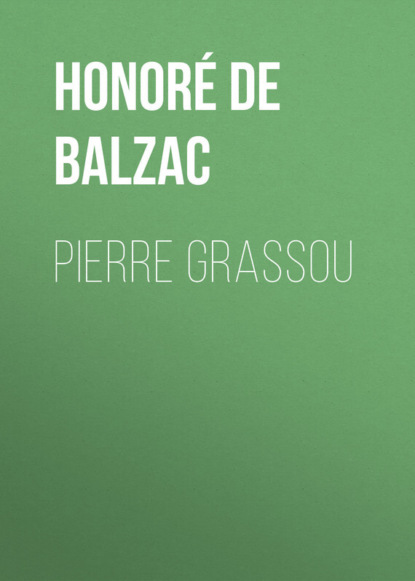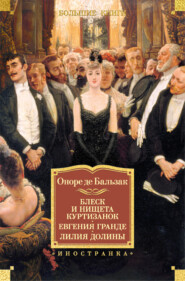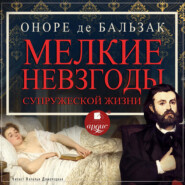По всем вопросам обращайтесь на: info@litportal.ru
(©) 2003-2024.
✖
Pierre Grassou
Настройки чтения
Размер шрифта
Высота строк
Поля
Honoré Balzac
Honoré de Balzac
Pierre Grassou
PIERRE GRASSOU
Whenever you have gone to take a serious look at the exhibition of works of sculpture and painting, such as it has been since the revolution of 1830, have you not been seized by a sense of uneasiness, weariness, sadness, at the sight of those long and over-crowded galleries? Since 1830, the true Salon no longer exists. The Louvre has again been taken by assault, – this time by a populace of artists who have maintained themselves in it.
In other days, when the Salon presented only the choicest works of art, it conferred the highest honor on the creations there exhibited. Among the two hundred selected paintings, the public could still choose: a crown was awarded to the masterpiece by hands unseen. Eager, impassioned discussions arose about some picture. The abuse showered on Delacroix, on Ingres, contributed no less to their fame than the praises and fanaticism of their adherents. To-day, neither the crowd nor the criticism grows impassioned about the products of that bazaar. Forced to make the selection for itself, which in former days the examining jury made for it, the attention of the public is soon wearied and the exhibition closes. Before the year 1817 the pictures admitted never went beyond the first two columns of the long gallery of the old masters; but in that year, to the great astonishment of the public, they filled the whole space. Historical, high-art, genre paintings, easel pictures, landscapes, flowers, animals, and water-colors, – these eight specialties could surely not offer more than twenty pictures in one year worthy of the eyes of the public, which, indeed, cannot give its attention to a greater number of such works. The more the number of artists increases, the more careful and exacting the jury of admission ought to be.
The true character of the Salon was lost as soon as it spread along the galleries. The Salon should have remained within fixed limits of inflexible proportions, where each distinct specialty could show its masterpieces only. An experience of ten years has shown the excellence of the former institution. Now, instead of a tournament, we have a mob; instead of a noble exhibition, we have a tumultuous bazaar; instead of a choice selection we have a chaotic mass. What is the result? A great artist is swamped. Decamps' "Turkish Cafe," "Children at a Fountain," "Joseph," and "The Torture," would have redounded far more to his credit if the four pictures had been exhibited in the great Salon with the hundred good pictures of that year, than his twenty pictures could, among three thousand others, jumbled together in six galleries.
By some strange contradiction, ever since the doors are open to every one there has been much talk of unknown and unrecognized genius. When, twelve years earlier, Ingres' "Courtesan," and that of Sigalon, the "Medusa" of Gericault, the "Massacre of Scio" by Delacroix, the "Baptism of Henri IV." by Eugene Deveria, admitted by celebrated artists accused of jealousy, showed the world, in spite of the denials of criticism, that young and vigorous palettes existed, no such complaint was made. Now, when the veriest dauber of canvas can send in his work, the whole talk is of genius neglected! Where judgment no longer exists, there is no longer anything judged. But whatever artists may be doing now, they will come back in time to the examination and selection which presents their works to the admiration of the crowd for whom they work. Without selection by the Academy there will be no Salon, and without the Salon art may perish.
Ever since the catalogue has grown into a book, many names have appeared in it which still remain in their native obscurity, in spite of the ten or a dozen pictures attached to them. Among these names perhaps the most unknown to fame is that of an artist named Pierre Grassou, coming from Fougeres, and called simply "Fougeres" among his brother-artists, who, at the present moment holds a place, as the saying is, "in the sun," and who suggested the rather bitter reflections by which this sketch of his life is introduced, – reflections that are applicable to many other individuals of the tribe of artists.
In 1832, Fougeres lived in the rue de Navarin, on the fourth floor of one of those tall, narrow houses which resemble the obelisk of Luxor, and possess an alley, a dark little stairway with dangerous turnings, three windows only on each floor, and, within the building, a courtyard, or, to speak more correctly, a square pit or well. Above the three or four rooms occupied by Grassou of Fougeres was his studio, looking over to Montmartre. This studio was painted in brick-color, for a background; the floor was tinted brown and well frotted; each chair was furnished with a bit of carpet bound round the edges; the sofa, simple enough, was clean as that in the bedroom of some worthy bourgeoise. All these things denoted the tidy ways of a small mind and the thrift of a poor man. A bureau was there, in which to put away the studio implements, a table for breakfast, a sideboard, a secretary; in short, all the articles necessary to a painter, neatly arranged and very clean. The stove participated in this Dutch cleanliness, which was all the more visible because the pure and little changing light from the north flooded with its cold clear beams the vast apartment. Fougeres, being merely a genre painter, does not need the immense machinery and outfit which ruin historical painters; he has never recognized within himself sufficient faculty to attempt high-art, and he therefore clings to easel painting.
At the beginning of the month of December of that year, a season at which the bourgeois of Paris conceive, periodically, the burlesque idea of perpetuating their forms and figures already too bulky in themselves, Pierre Grassou, who had risen early, prepared his palette, and lighted his stove, was eating a roll steeped in milk, and waiting till the frost on his windows had melted sufficiently to let the full light in. The weather was fine and dry. At this moment the artist, who ate his bread with that patient, resigned air that tells so much, heard and recognized the step of a man who had upon his life the influence such men have on the lives of nearly all artists, – the step of Elie Magus, a picture-dealer, a usurer in canvas. The next moment Elie Magus entered and found the painter in the act of beginning his work in the tidy studio.
"How are you, old rascal?" said the painter.
Fougeres had the cross of the Legion of honor, and Elie Magus bought his pictures at two and three hundred francs apiece, so he gave himself the airs of a fine artist.
"Business is very bad," replied Elie. "You artists have such pretensions! You talk of two hundred francs when you haven't put six sous' worth of color on a canvas. However, you are a good fellow, I'll say that. You are steady; and I've come to put a good bit of business in your way."
"Timeo Danaos et dona ferentes," said Fougeres. "Do you know Latin?"
"No."
"Well, it means that the Greeks never proposed a good bit of business to the Trojans without getting their fair share of it. In the olden time they used to say, 'Take my horse.' Now we say, 'Take my bear.' Well, what do you want, Ulysses-Lagingeole-Elie Magus?"
These words will give an idea of the mildness and wit with which Fougeres employed what painters call studio fun.
"Well, I don't deny that you are to paint me two pictures for nothing."
"Oh! oh!"
"I'll leave you to do it, or not; I don't ask it. But you're an honest man."
"Come, out with it!"
"Well, I'm prepared to bring you a father, mother, and only daughter."
"All for me?"
"Yes – they want their portraits taken. These bourgeois – they are crazy about art – have never dared to enter a studio. The girl has a 'dot' of a hundred thousand francs. You can paint all three, – perhaps they'll turn out family portraits."
And with that the old Dutch log of wood who passed for a man and who was called Elie Magus, interrupted himself to laugh an uncanny laugh which frightened the painter. He fancied he heard Mephistopheles talking marriage.
"Portraits bring five hundred francs apiece," went on Elie; "so you can very well afford to paint me three pictures."
"True for you!" cried Fougeres, gleefully.
"And if you marry the girl, you won't forget me."
"Marry! I?" cried Pierre Grassou, – "I, who have a habit of sleeping alone; and get up at cock-crow, and all my life arranged – "
"One hundred thousand francs," said Magus, "and a quiet girl, full of golden tones, as you call 'em, like a Titian."
"What class of people are they?"
"Retired merchants; just now in love with art; have a country-house at Ville d'Avray, and ten or twelve thousand francs a year."
"What business did they do?"
"Bottles."
"Now don't say that word; it makes me think of corks and sets my teeth on edge."
"Am I to bring them?"
"Three portraits – I could put them in the Salon; I might go in for portrait-painting. Well, yes!"
Old Elie descended the staircase to go in search of the Vervelle family. To know to what extend this proposition would act upon the painter, and what effect would be produced upon him by the Sieur and Dame Vervelle, adorned by their only daughter, it is necessary to cast an eye on the anterior life of Pierre Grassou of Fougeres.
When a pupil, Fougeres had studied drawing with Servin, who was thought a great draughtsman in academic circles. After that he went to Schinner's, to learn the secrets of the powerful and magnificent color which distinguishes that master. Master and scholars were all discreet; at any rate Pierre discovered none of their secrets. From there he went to Sommervieux' atelier, to acquire that portion of the art of painting which is called composition, but composition was shy and distant to him. Then he tried to snatch from Decamps and Granet the mystery of their interior effects. The two masters were not robbed. Finally Fougeres ended his education with Duval-Lecamus. During these studied and these different transformations Fougeres' habits and ways of life were tranquil and moral to a degree that furnished matter of jesting to the various ateliers where he sojourned; but everywhere he disarmed his comrades by his modesty and by the patience and gentleness of a lamblike nature. The masters, however, had no sympathy for the good lad; masters prefer bright fellows, eccentric spirits, droll or fiery, or else gloomy and deeply reflective, which argue future talent. Everything about Pierre Grassou smacked of mediocrity. His nickname "Fougeres" (that of the painter in the play of "The Eglantine") was the source of much teasing; but, by force of circumstances, he accepted the name of the town in which he had first seen light.
Grassou of Fougeres resembled his name. Plump and of medium height, he had a dull complexion, brown eyes, black hair, a turned-up nose, rather wide mouth, and long ears. His gentle, passive, and resigned air gave a certain relief to these leading features of a physiognomy that was full of health, but wanting in action. This young man, born to be a virtuous bourgeois, having left his native place and come to Paris to be clerk with a color-merchant (formerly of Mayenne and a distant connection of the Orgemonts) made himself a painter simply by the fact of an obstinacy which constitutes the Breton character. What he suffered, the manner in which he lived during those years of study, God only knows. He suffered as much as great men suffer when they are hounded by poverty and hunted like wild beasts by the pack of commonplace minds and by troops of vanities athirst for vengeance.

















